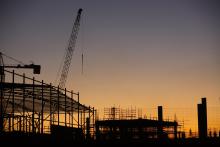Growth prospects for the UK construction industry in 2018 have been downgraded as the UK prepares to leave the EU, according to the latest forecasts by the Construction Products Association.
Output is expected to soften as a slowing economy, falling real wages and rising costs adversely affect the industry, growth for 2018 is therefore only expected to rise by 0.7%, the slowest in six years, and a downward revision from 1.2% in previous forecasts.
For now, activity on site is high and output is expected to rise by 1.6% in 2017, a revision upwards from 1.3% in previous forecasts. This will be partly due to a sharp rise from new contracts and activity in the £6.9 billion public housing repair, maintenance and improvements to deal with short-term urgent measures that will need to be made in light of the Grenfell Tower fire.
An increase in infrastructure activity and private housebuilding are expected to be the primary drivers of growth over the next two years which will help offset a sharp fall in the commercial and industrial sectors. Growth in infrastructure will be due to major projects in rail and water & sewerage such as HS2 and the Thames Tideway Tunnel, with activity forecast to grow by 7.4% in 2017 and 6.4% in 2018.
Growth will be reliant on delivery of these projects and the extent of the continued delays to main works at Hinkley Point C have resulted in it no longer included in the Construction Products Association forecasts. ??Growth for the industry in 2018 will also be heavily reliant on private housebuilding, however the sector is still reliant on Help to Buy equity loans to drive housebuilding numbers.
The policy is in place until 2021, which is expected to support demand for new build and drive growth in private housing starts of 3.0% in 2017 and 2.0% in 2018. However, this is slower than in previous years given uncertainties over the strength of consumer confidence and falls in real earnings.??Looking further ahead, growth for 2019 is projected to be 1.8%, but given the unprecedented economic and political uncertainties following the lack of a significant majority for the UK government as the UK leaves the EU, the risks around this forecast are considerable.
Noble Francis, economics director at the Construction Products Association, said: "Construction firms are still reporting that activity remains high and there are still lots of cranes around. But there are clear signs that construction output is slowing and that next year, in particular, will be difficult for the industry. Prospects for construction have been adversely affected by slowing UK economic growth and falling real wages on one side and sharp rising costs on the other."
"A fall in new investment, especially where it is large international investment looking for a long-term rate of return, is forecast to lead to declines in the commercial and industrial sectors.??"
Despite the slowdown in the general housing market, particularly in London, house builders continue to increase supply, albeit more slowly than in recent years. Currently, more than a third of new house building is being sustained by the government's Help to Buy and should continue to do so over the next 18 months if the wider economy and housing market don’t slow further.
However, if economic conditions do deteriorate further, house builders can react quite quickly if necessary.
"Increases in infrastructure investment are also expected to offset these declines and be the key driver of any construction growth going forward. However, concerns regarding rising costs and delays to major projects continue to dog the sector so there remains a high degree of uncertainty around infrastructure growth in the next few years. And this infrastructure investment will be vital for the industry as a whole. Without it, total construction output would fall by 1.0% in 2018."
Published in Aggregates Business Europe







